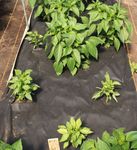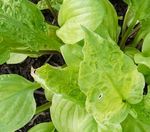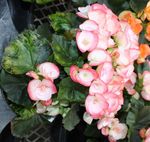Recognizing and Preventing Viral Diseases in the Greenhouse
←
→
Page content transcription
If your browser does not render page correctly, please read the page content below
Beth Scheckelhoff
scheckelhoff.11@osu.edu
Volume 11 Number18 March 2022
Recognizing and Preventing 2022 Sponsors
Viral Diseases in the
Greenhouse
This alert features key strategies for growers to consider and
discuss to manage plant viruses in the greenhouse.
Plant viruses are serious
pests of ornamental and
edible crops alike and cause
significant losses for
greenhouse producers. Once
infected, a plant will remain
infected with the viral
disease throughout its
lifespan – and may pass the
virus along to progeny. There
are no chemical or biological
products that cure plants
infected with a virus.
Instead, prevention is key for
successful management of Figure 1. A tuberous begonia with mottled
viral diseases in greenhouse leaves tested positive for Impatiens necrotic
spot virus (INSV).
Reprint with permission from the
crops. author(s) of this e-GRO Alert.
Growers and greenhouse employees should be able to recognize common signs of plant
viruses. Viruses can cause unusual physical characteristics like mosaic patterns,
ringspots, mottling, leaf distortion, stunting, and yellowing, among others (Figures 1, 2,
3, and 4). While these symptoms may also result from other issues like nutrient
disorders, other pests, or even unique attributes like variegation or speckling, training
employees to spot usual versus unusual characteristics for a particular plant will help
diagnose and correct many production problems. In some cases, infected plants may
show no symptoms and evade detection.
www.e-gro.org
1e-GRO Alert - 2022 Viral Diseases
Figure 2. Vein clearing, mottling, leaf distortion, and variable coloration are common symptoms found in different Hosta cultivars
infected with Hosta Virus X (HVX). Infected plants cannot be cured and must be removed from the greenhouse and destroyed.
Start Virus-free. Plant viruses can infect
greenhouse crops in many ways. Viruses can
come in on plant material – from seeds to
cuttings, plugs, and/or mature plants. A
grower’s first line of defense is to begin with
virus-free plant material. How can you start
with virus-free plants?
Choose varieties or cultivars that have
genetic resistance to common viruses, when
possible. Many food crops and a limited
number of ornamental crops have genetic
resistance or increased tolerance to one or
more viruses.
If resistance packages are not available for
specific plants, purchase certified virus-free Figure 3. Sweet pepper plants with tobacco mosaic
seed, cuttings, or plantlets. virus (TMV) are stunted with curled and distorted
leaves compared to healthy plants. TMV survives in
When neither of these options are available plant debris and on seeds and is often transmitted
mechanically through plant wounds.
for the plants you grow, quarantine
incoming plants and train all employees to Figure 4.
look for unusual symptoms that may be Ringspots and
mosaic patterns
present or develop over time. are hallmark
symptoms of rose
mosaic disease
caused by Prunus
Viral Vectors. Thrips, aphids, and leafhoppers necrotic ringspot
are well-known vectors of plant viruses in virus (PNRSV)
and/or apple
ornamental plants. Monitoring and controlling mosaic virus
(ApMS)
insect populations are key strategies to prevent
virus transmission (Figure 5). Here are some tips
to exclude common vectors of plant viruses:
www.e-gro.org 2e-GRO Alert - 2022 Viral Diseases
Figure 5. Numerous thrips are present on this Campanula Figure 6. Remove weeds from in and around the greenhouse.
flower. Monitor thrips populations with yellow or blue sticky Many weed species serve as virus reservoirs and support insect
cards throughout the growing season. Control measures should vectors like thrips and aphids.
be taken when thrips numbers reach threshold levels.
• Install exclusion screens to keep insects out of growing environments.
• Remove weeds and volunteer plants from in and around greenhouses, retail areas,
and buildings (Figure 6). Many viruses can be found in a wide range of host plants –
including weeds, native plants, agronomic and vegetables crops, as well as
ornamentals. These alternate hosts serve as reservoirs for viruses.
• Grow trap crops to attract insects such as thrips and aphids. Regular monitoring of
these plants will alert you insect pressure before reaching more sensitive crops.
Mechanical spread. Viruses can also spread mechanically from our clothing, hands, and
tools through routine practices like pruning, deadheading, propagation, and handling of
plant material. Routine and frequent disinfection of tools can help prevent spread.
Employees should also routinely wash and sanitize their hands when directly handling
plant material, especially those suspected of having a virus.
Remain Virus Vigilant. Continue scouting in the greenhouse throughout the growing
season, removing suspect plants as they are found. Once plants are infected with a virus,
they cannot be cured - but can serve as a reservoir from which other plants become
infected. Remove and discard diseased plants.
Suspect plants can be sent to diagnostic clinics across the US. Unsure of which
universities have a diagnostic clinic? Check the National Plant Diagnostic Network
website (npdn.org) to see plant diagnostic clinics in regions across the US. It is a good
idea to contact the diagnostic clinic of your choice to determine their virus testing
capabilities. In some instances, plant samples may be directed to another facility for
more comprehensive testing.
www.e-gro.org 3e-GRO Alert - 2022
e-GRO Alert Cooperating Universities
www.e-gro.org
CONTRIBUTORS
Dr. Nora Catlin
FloricultureSpecialist
Cornell Cooperative Extension
Suffolk County
nora.catlin@cornell.edu
Dr. Chris Currey
Assistant Professor of Floriculture
Iowa State University
ccurrey@iastate.edu
Dr. Ryan Dickson
Greenhouse Horticulture and
Controlled-Environment Agriculture
University of Arkansas
ryand@uark.edu
Thomas Ford
Commercial HorticultureEducator
Penn State Extension
tgf2@psu.edu
Dan Gilrein
Entomology Specialist
Cornell Cooperative Extension
Suffolk County
dog1@cornell.edu
Dr. Chieri Kubota
Controlled Environments Agriculture
The Ohio State University
kubota.10@osu.edu
Heidi Lindberg
Floriculture Extension Educator
Michigan State University
wolleage@anr.msu.edu
Dr. Roberto Lopez
Floriculture Extension & Research
Michigan State University
rglopez@msu.edu
Dr. Neil Mattson
Greenhouse Research & Extension
Cornell University
neil.mattson@cornell.edu
Dr. W. Garrett Owen
Greenhouse Extension & Research
University of Kentucky
wgowen@uky.edu
Dr. Rosa E. Raudales
Greenhouse Extension Specialist
University of Connecticut
rosa.raudales@uconn.edu
In cooperation with our local and state greenhouse organizations
Dr. Alicia Rihn
Agricultural & Resource Economics
University of Tennessee-Knoxville
arihn@utk.edu
Dr. Debalina Saha
Horticulture Weed Science
Michigan State University
sahadeb2@msu.edu
Dr. Beth Scheckelhoff
Extension Educator – GreenhouseSystems
The Ohio State University
scheckelhoff.11@osu.edu
Dr. Ariana Torres-Bravo
Horticulture/ Ag. Economics
PurdueUniversity
torres2@purdue.edu
Dr. Brian Whipker
Floriculture Extension & Research
NC State University
bwhipker@ncsu.edu
Dr. Jean Williams-Woodward
Ornamental Extension Plant Pathologist
University of Georgia
jwoodwar@uga.edu
Copyright © 2022
Where trade names, proprietary products, or specific
equipment are listed, no discrimination is intended and
no endorsement, guarantee or warranty is implied by
the authors, universities or associations.
www.e-gro.org 4You can also read



























































